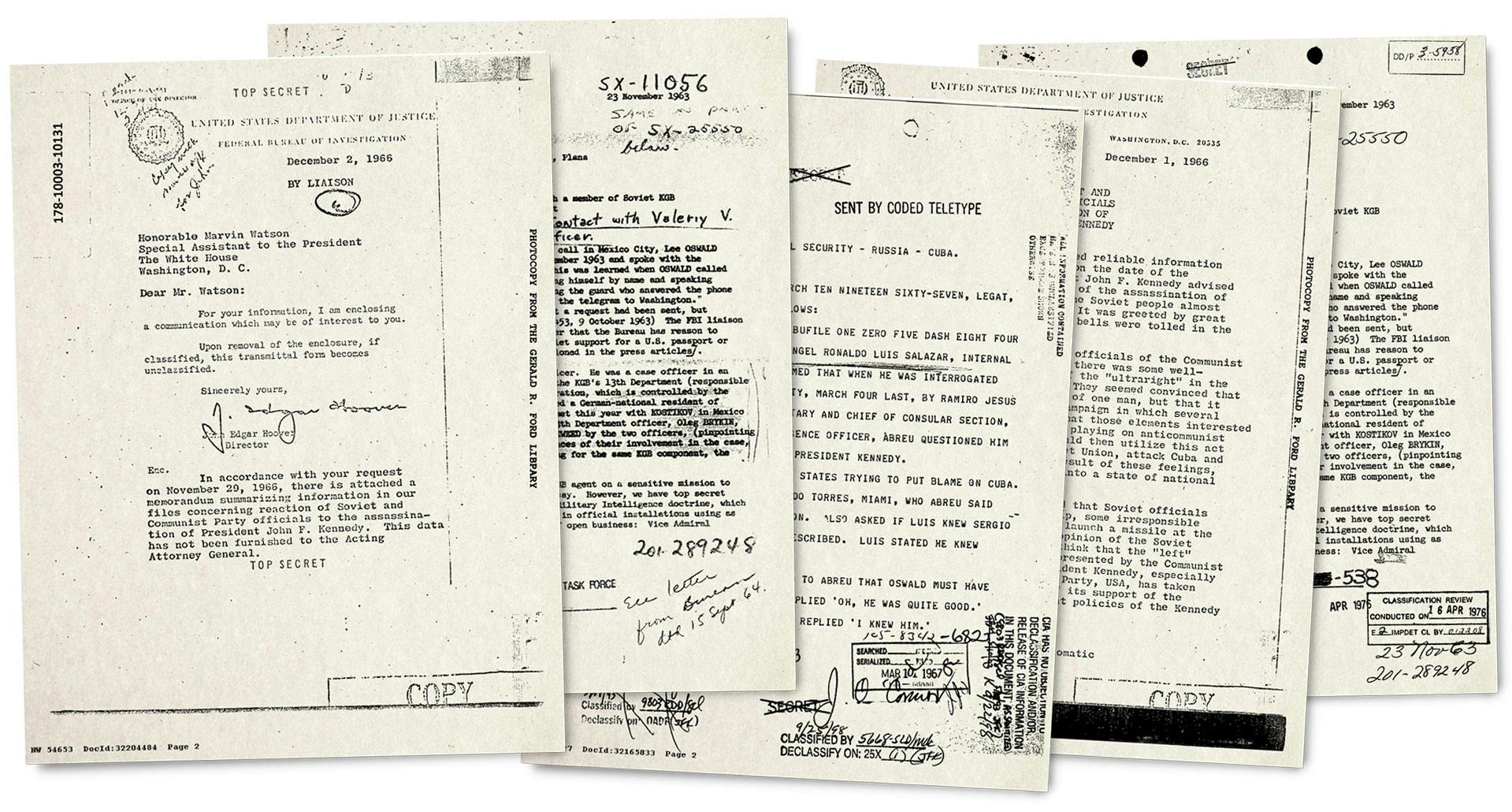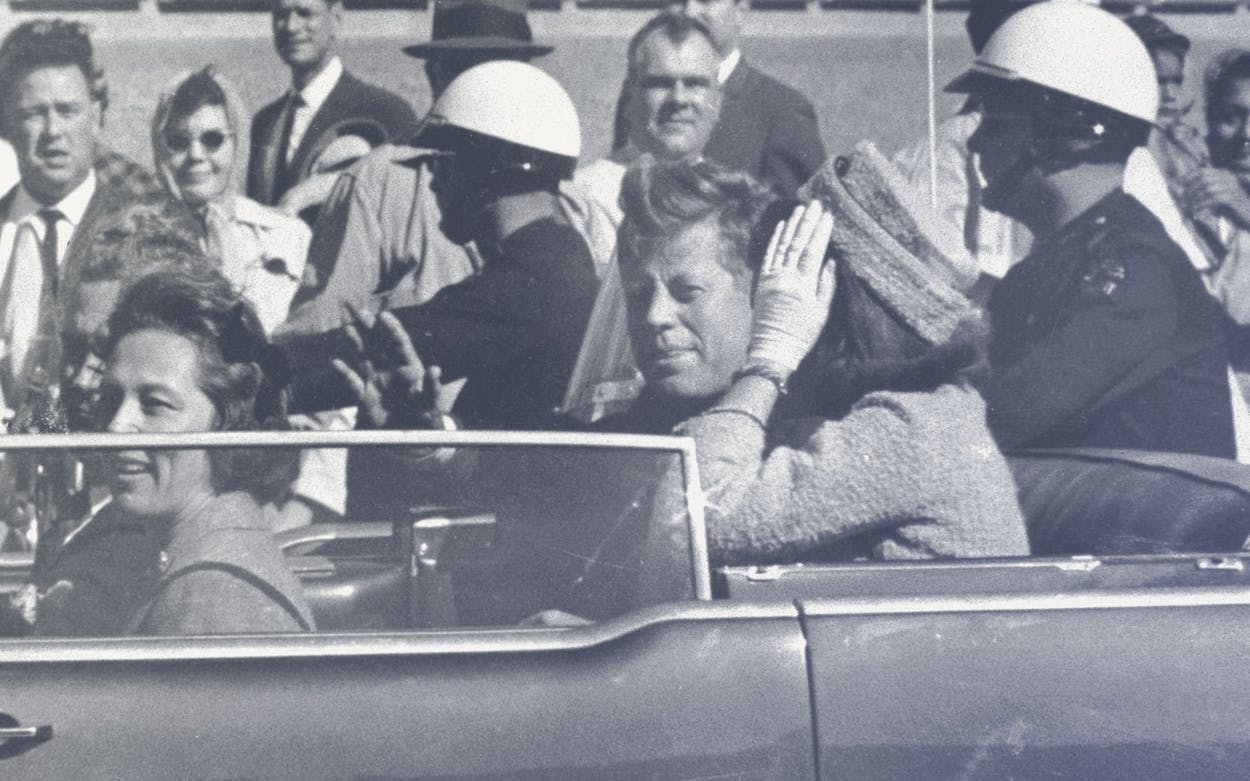This story originally appeared in the December 2017 issue with the headline “A Dealey Plaza of the Mind.”
To some, the American Century had a well-defined peak. When President John F. Kennedy’s Lincoln Continental turned left at the intersection of Houston and Elm Streets in downtown Dallas, the nation was in the midst of postwar consensus and prosperity; by the time the vehicle had reached the triple underpass at the bottom of Dealey Plaza, the country was headed toward a great unraveling. Or so the story goes.
On October 26 and November 3 the National Archives released 3,567 previously sealed documents relating to the Kennedy assassination, as mandated by a 1992 law that Congress passed with the intention of someday clearing the air. While dozens of documents affected by the law remain classified, the recent release is probably the last significant injection of new information into the psychic landscape in which assassination theorists like Mark North have resided for the past 54 years.
North, who lives in Austin, is a retired lawyer and university administrator and the author of two books on the assassination: Act of Treason: The Role of J. Edgar Hoover in the Assassination of President Kennedy (1991) and Betrayal in Dallas: LBJ, the Pearl Street Mafia, and the Murder of President Kennedy (2011). North was ten when his elementary school classroom was invaded by the news and his entire class was sent home midday. “I was glued to the TV the whole weekend,” he said. Two days later, a bleary-eyed North got to see Jack Ruby’s intercession in the case. “I stood there and watched [Lee Harvey] Oswald get shot, live on television.”
A suspicion that something was amiss in the official narrative was confirmed by a screening of the Zapruder film North attended in college. “It was clear that he had been shot from the right front,” he said, not behind, as everyone had been told. That helped launch a lifetime fascination with the case.
Alternative theories of the assassination range from the relatively sober to the cartoonish—for example, that Jackie Kennedy did it. North’s thesis, which he’s spent several decades honing, is that Robert F. Kennedy’s investigations of organized crime posed an existential threat to the Dallas Mafia, which was inextricably bound up with the city’s legal and political establishment. That latter group included, by extension, Vice President Lyndon Johnson, who, according to North, preferred that investigators not dwell on the political seediness of his home turf. American intelligence agencies favored a left-wing dupe like Oswald as the villain, and FBI director J. Edgar Hoover was happy not to ask too many questions either.
These days, North seems more resigned than animated by all of this. Though some conspiracy theorists were excited about the release of the new material, he sounded fatalistic; to him, the release was a marker of the passage of time as much as anything else. “I don’t know if these documents will [support] what’s in my book,” he said, speaking the week before the release. “I would hope so. But I don’t feel that there’s something I need to see in there.” He’d already unearthed what he thought needed to be unearthed.

In 1991, when North’s first book was published, the assassination community was vibrant and argumentative. Oliver Stone’s JFK came out that year, and North was interviewed on Larry King Live and Geraldo. “There was a lot of animosity [among conspiracy theorists] back then, a lot of infighting,” he said. “The CIA people, the Mason people, the Big Oil people, the military-industrial complex people were all working against each other. It was almost a question of, ‘Who didn’t do it?’ ” North focused on the Mafia and the FBI and got more pushback from other theorists than from the Feds.
In hindsight, he wonders if the proliferation of strange theories hadn’t been encouraged by the government, in the same way a defense attorney will try to “sow doubt in the juror’s mind by throwing out a bunch of other different suspects.” But he prefers that din to the slow fading of the cultural memory of the assassination that he sees today. He spent years digging in archives, doing interviews, and pulling documents from government agencies for his second book, which he regards as a far more authoritative work than his first. “I was surprised by the reaction to it,” he said. “I thought it would generate more public discussion.”
Reached a few days after the release of the documents, North confirmed that his low expectations of their contents had been met. The files contain a lot of embarrassing material about the CIA, which is most likely why they remained classified for so long, but precious little new information about Kennedy. Others had noted a few hints of something strange, enough to keep speculation going, but “nothing that addresses the material in my book,” North said. “A lot of this is kind of old stuff.” He no longer expects that a “smoking gun” will ever appear, but he would like to see the government someday “step up to the plate” and “man up and say, ‘This is what happened.’ ”
“I kind of feel like I’ve done my part,” North said. The loss of a sense of trust and security experienced by his ten-year-old self has never left him, but in the intervening years the cycles of paranoia and fear have multiplied and sped up for everybody else. Though the September 11 attacks provided conspiracy fodder for a younger generation, now even that has all but vanished. The weekend of the October document dump was full of speculation about special prosecutor Robert Mueller’s then-imminent indictments of Trump campaign officials allegedly involved in another bizarre international conspiracy, and John Fitzgerald Kennedy quickly faded from the news. “People have so much else on their minds now,” North said.









